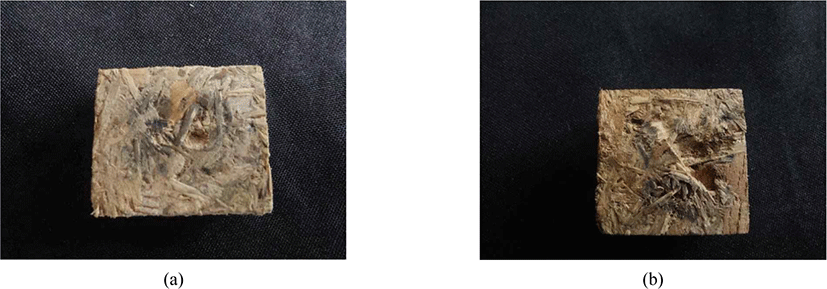1. INTRODUCTION
Indonesia is one of the countries that produces particle boards for domestic and export purposes (Lee et al., 2022). Particleboard can be used a substitute for solid wood. In 2023, the production of particle board was 202,644.92 m3 (BPS, 2024), an increase of 121.59% compared with that of 2022, which was 166,654.90 m3 (BPS, 2023).
The utilization of residual natural fibers from agricultural waste as reinforcement materials and for particleboard applications has been explored, including nipah palm frond (Ghani et al., 2024), tea oil camellia fruit shells (Chaydarreh et al., 2021), sorghum (Sorghum bicolor; Sutiawan et al., 2024), kenaf (Wan Nadhari et al., 2024), oil palm trunks (Lubis et al., 2024; Zakaria et al., 2021), bamboo stems (Iswanto et al., 2020), and sengon wood (Karliati et al., 2024; Marwanto et al., 2018). Recently, in Indonesia, there has been a shift toward using fast-growing wood materials for particleboard production in Indonesia, owing to their rapid availability. Among the fast-growing wood species used in the Indonesian timber industry, sengon wood is notable (Karliati et al., 2024; Marwanto et al., 2018). Furthermore, Indonesia and Malaysia are the primary producers of palm oil (Nuryawan et al., 2022), palm waste is produced in the form of oil palm trunks (Pulingam et al., 2022), and oil palm trunk is a potential raw material for particle board (Zakaria et al., 2021). The incorporation of mixed-particle raw materials can enhance the quality of manufactured biocomposites, such as bamboo-oriented strand boards (Maulana et al., 2021).
The limitations of wood-based panels such as particleboard products include low dimensional stability against changes in environmental moisture content and the susceptibility to attacks by wood-destroying insects (Hartono et al., 2023; Lee et al., 2023a). Researchers have successfully attempted to improve the resistance of composite boards to biological attacks treating boards (Lee et al., 2022). Among these treatments is the use of wood vinegar (Arsyad et al., 2019; Sunarti et al., 2014). Research has indicated that the durability of particle board with the addition of wood vinegar from durian fruit peel at concentrations of 10% increased the durability of particle board against termite attacks (Pardosi et al., 2012).
Wood vinegar, including that obtained from various types of wood and biomass (Oramahi et al., 2022b, 2023, 2024), has been used as an antitermitic treatment (Oramahi et al., 2020a; Suprianto et al., 2023) and as an antifungal treatment (Kuswadi et al., 2023; Oramahi et al., 2010).
Wood vinegar obtained from durian wood (Durio sp.) exhibited antitermitic properties against Coptotermes formosanus Holmgren in a no-choice experiment (Suprianto et al., 2023). Oramahi et al. (2024) reported the main components of mabang wood vinegar as 1,2-ethanadiol, acetic acid, phenol, 1-(2-furanyl)-ethanone, 2-propanone, and methyl ester. Additionally, the chemical component in wood vinegar was effective as the antitermitic and antifungal treatments (Oramahi et al., 2023; Suprianto et al., 2023).
Variations in raw material types and pyrolysis temperatures during wood vinegar production influence its characteristics, such as constituent chemicals and yield (Manmeen et al., 2023; Oramahi et al., 2020b, 2023) but increase the number of variables that must be observed to produce the best particleboard. Because of the variety of research variables observed and to avoid insignificant analysis results on the durability of particle boards, response surface methodology (RSM) was used (Eyide et al., 2023).
RSM has been successfully used for the optimization of wood vinegar production (Oramahi et al., 2020b, 2022a, 2024), bioactive chemical components of wood vinegar (Oramahi et al., 2019), and particleboard characteristics (Baskaran et al., 2015; Lee et al., 2023b). However, using RSM increases the number of variables that must be observed to produce the best particleboard. Studies have used durability tests to determine the resistance to termite attacks. Researchers have used natural (Hermawan et al., 2024) and laboratory methods [no choice (Kadir et al., 2022) and multiple-choice (Cosme et al., 2018)] to determine the durability of wood products against termites. Cosme et al. (2020) showed that testing wood resistance to Cryptotermes brevis attacks had a significant influence on the results.
According to a review of the literature, no study has investigated the durability of particleboards made from a mixture of oil palm trunks and sengon wood sawdust with added wood vinegar and different concentrations of adhesive by using RSM. Thus, the aim of this study was to determine the durability of particleboard against Coptotermes curvignathus termites by using two testing methods: no-choice and multiple-choice.
2. MATERIALS and METHODS
Oil palm trunks and sengon wood, estimated to be 20 and 10 years old, respectively, were harvested from the Tanjungpura University area and collected from furniture home businesses in Pontianak. Next, the chopped oil palm trunks were allowed to dry for one week in the sun. Finally, the oil palm trunks and sengon wood were ground to a particle size of 2.3 mm, and the sawdust was dried in an oven set at 60°C to a moisture level of 5%. The wood vinegar was produced from sengon wood (Kuswadi et al., 2023).
A total of 15 single-layer panels with a density of 0.7 g/cm3 were produced. Three of each combination were made from oil palm and sengon particles: adhesive concentration (urea formaldehydes) was 12%, 14%, and 16%; wood vinegar concentration was 5%, 10%, and 15%; and the ratio of oil palm trunk and sengon wood sawdust was 25:75, 50:50, and 75:25 (Table 1). Hand-formed mats in a 30 cm × 30 cm frame were compressed to a thickness of 1.0 cm. The boards were stored in a room maintained at 26 ± 2°C and a relative humidity of 70% ± 2% until the moisture content of the boards reached 5%. The particleboard was cut to a length, width, and thickness of 2 × 2 × 1 cm, respectively. The samples were oven-dried at 100°C until they reached a constant initial weight.
Termite tests were conducted using two methodologies: multiple- and no-choice feeding. Termites (C. curvignathus Holmgren subterranean) were collected from the rubber forests of Java Tengah Village, Sungai Ambawang District, and Kubu Raya Regency along with the tree trunks they attacked and brought to the termite house of the Faculty of Forestry, Tanjungpura University. Termite conditioning was performed for one month before the feeding test process was conducted.
The laboratory subterranean termite attack test used in this study was based on Indonesian standards (SNI, 2006). In the no-choice test method, a glass container was used to hold each wood test specimen and 200 g sterilized sand. The sand was moistened with sufficient water to achieve a moisture content of 7%, which is the maximum amount of water the sand can hold. Each container was supplemented with 50 healthy and active workers from a laboratory colony of C. curvignathus, a Holmgren’s subterranean termite.
For the multiple-choice test, five plastic containers with a diameter of 18 cm and height of 5.5 cm were used. Each container was filled with sterile sand as high as ± 1 cm (100 g) and moistened with 20 mL water to maintain humidity. Plastic gauze measuring 16 cm in diameter was placed on top of the sand to prevent direct contact of the sample with the sand. Each treatment sample was allocated to a separate test container, and 200 subterranean termites were introduced into each container, with a worker-to-soldier caste ratio of 180:20. Fig. 1 illustrates the disparity in the positioning of test samples between the no-choice and multiple-choice methods.
The containers were stored for three weeks in a poorly lit room with a temperature of 25°C–30°C and a relative humidity of 80%–90%. The weight of the sand was monitored every week, and if the moisture content decreased by 2% or more, water was supplied to increase it to the required level. After the exposure period, the particleboard specimens were cleaned and oven-dry weighted at 100°C. The endpoints assessed were particleboard mass loss (mg), termite feeding rate, wood resistance class, termite mortality, particleboard moisture content, and particleboard protection level.
The formulas for calculating the moisture content and percentage of particleboard weight loss were based on those of Thybring (2013).
Where W0 and W1 are oven-dried weight and air-dried weight, respectively, and MC is the moisture content.
Where T1 is the number of live termites before the test, and T2 is the number of live termites after the test.
Where W3 is the oven-dried weight of the specimen before the test (mg), and W4 is the oven-dried weight of the specimen after the test (mg).
The optimization procedure was designed based on a three-factor inscribed Box-Behnken design (BBD) with independent variables: adhesive concentration was 12%, 14%, and 16%; wood vinegar concentration was 5%, 10%, and 15%; and ratios of oil palm trunk and sengon wood sawdust were 25:75, 50:50, and 75:25. There were three levels of each variable for a total 15 of runs (Table 1).
BBD applied termite mortality (Y1), weight loss of particleboard for the no-choice test (Y2), weight loss of particleboard for the multiple-choice test (Y3) as a function of adhesive concentration (X1), wood vinegar concentration (X2), and a ratio of oil palm trunk to sengon wood sawdust (X3; Table 1). For the RSM design points, these variables were categorized as low, medium, or high. As indicated in the literature, to track how the independent factors affect the response, we conducted an experiment using BBD (Li et al., 2024; Liu et al., 2013).
For optimal point prediction, the second-order polynomial equation was as follows:
Where β0βi, βii, and βij are the regression coefficients for the intercept, linear, quadratic, and interaction terms, respectively, and χi and χj are the independent variables (Sodeifian et al., 2018, 2019).
The analysis of variance for the response of the surface quadratic model and the statistical significance of the influence was analyzed using F-tests. The significance of each term was calculated using the F-value and Prob > F-values, with larger F-values indicating that the term was significant (Anderson-Cook et al., 2009; Safari et al., 2018).
3. RESULTS and DISCUSSION
The response correlation was determined using second-order BBD. Table 2 presents the overall responses of the proposed experimental design to termite mortality and particleboard weight loss. To provide all responses with a clear representation of the interactions between variables, we used a quadratic model in software. The variables in response in Equations (5) to (7) were coded values representing termite mortality (Y1), weight loss of particleboard for the no-choice test (Y2), and weight loss of particleboard for the multiple-choice test (Y3) as a function of adhesive concentration (X1), concentration of wood vinegar (X2), and ratio of oil palm trunk and sengon wood sawdust (X3). These equations were derived from the experimental data of the model. The final equations in terms of the coded factors are expressed in Equations (5) to (7).
X1, adhesive concentration (%); X2, wood vinegar concentration (%); X3, ratio of oil palm trunk and Sengon wood sawdust; Y1, weight loss of particle board in the no-choice test; Y2, weight loss of particle board in the multiple-choice test; Y3, termite mortality; A, actual value (actual value in Y3 is data transformation with Excel in formula = DEGREES (ASIN((data actual/100)^0,5)); and P is the prediction value with response surface methodology.
A second-order BBD was employed to establish relationships between the responses. Table 2 shows the collective responses of the proposed experimental design to termite mortality and particleboard weight loss. Using the aforementioned software, a quadratic model was selected for all the responses to elucidate the interactions among the variables. The response equations derived from the experimental data by using the model are expressed in Equations (5) to (7). The variables in those equations are represented by coded values: termite mortality (Y1); weight loss of particleboard for the no-choice test (Y2); and weight loss of particleboard for the multiple-choice test (Y3) as functions of adhesive concentration (X1), wood vinegar concentration (X2), and the ratio of oil palm trunk to sengon wood sawdust (X3). The final equations in terms of the coded factors are Equations (5) to (7).
Equation for termite mortality
Equation for weight loss of particle board for no-choice
Equation for weight loss of particle board for multiple-choice
These equations were used to calculate the actual and expected values from the experimental results. The suitability of the Box-Behnken model was tested, and its quality was assessed using analysis of variance. Additionally, it was used to estimate the effects of adhesive concentration (X1), wood vinegar concentration (X2), the ratio of oil palm trunk to sengon wood sawdust (X3), and their interactions with the responses as a function of termite mortality (Y1), as well as the weight loss of the particleboard for samples that had no choice (Y2) or multiple choices (Y3). Tables 3–5 display the regressions of the coefficients, model significance, and lack of fit, all of which were computed using statistical software.
The overall model fit was assessed using the coefficient of determination (R2). A model is deemed ideal when the R2 values are closer to 1, owing to this leading to better response prediction (Arabi et al., 2023). Tables 3–5 further show that the weight loss of the particleboard for the multiple-choice and termite mortality tests had R2 values of 0.924, 0.908, and 0.955, respectively. Based on the provided R2 values, we inferred that the fitted model only failed to explain 7.6% of the total variables for termite mortality, 9.2% for particleboard weight loss in the no-choice test, and 4.5% for particleboard weight loss in the multiple-choice test. The response R2 values were close to 1. For all replies (Table 5), the adjusted R2 and projected R2 were generally in reasonable agreement.
The weight loss of particleboard owing to termite attacks by using the no-choice method ranged from 1.10% to 3.08% (Fig. 2). The highest weight loss was in particleboard, which had a composition of X1 (14%), X2 (5%), and a ratio of X3 (75/25). The smallest weight loss in particleboard was in particleboard with a composition of X1 (16%), X2 (15%), and a ratio of X3 (50/50). Detailed data are shown in Table 2, where part of response Y1 is in the actual value (A). Data analysis to obtain optimal conditions for particleboard by using software (Design Expert, Stat-Ease, Minneapolis, MN, USA) with RSM, particularly with BBD presenting response surface plots in the form of surface and contour plots (three-dimensional, 3D), is capable of interpreting variable interactions and is highly informative (Adiyanto et al., 2023).
According to Baskaran et al. (2015), 3D response surface plots are informative and can be used to analyze how these factors interact. As shown in Fig. 3, the surface and contour plots of particleboard weight loss in the no-choice method illustrated the influence of variables X1 and X2, indicating optimum conditions at X1 (14%) and X2 (10%), with a particleboard weight loss value of 2.88%. Additionally, the influence of variables between X1 and the ratio of X3 on no-choice method for weight loss particleboard is illustrated in Fig. 4, showing optimum conditions at X1 (14%) and the ratio of X3 (50/50) with a particleboard weight loss of 2.88%. As shown in Fig. 5, interaction between X2 and the ratio of X3 indicated optimum conditions with X2 (15%) and the ratio of X3 (75/25) with a particleboard weight loss of 2.88%.
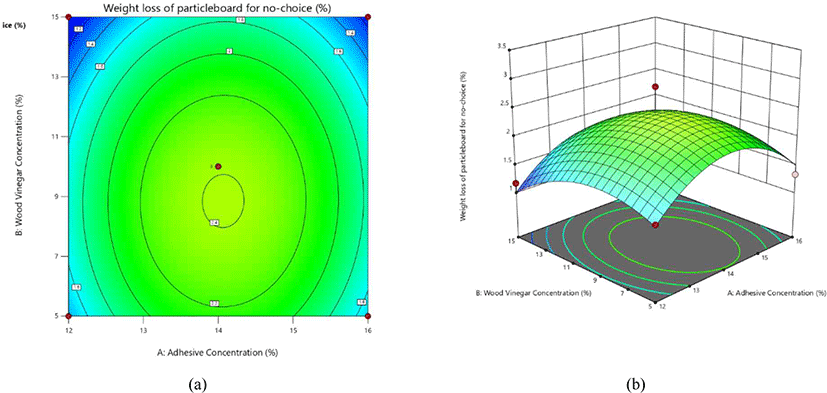
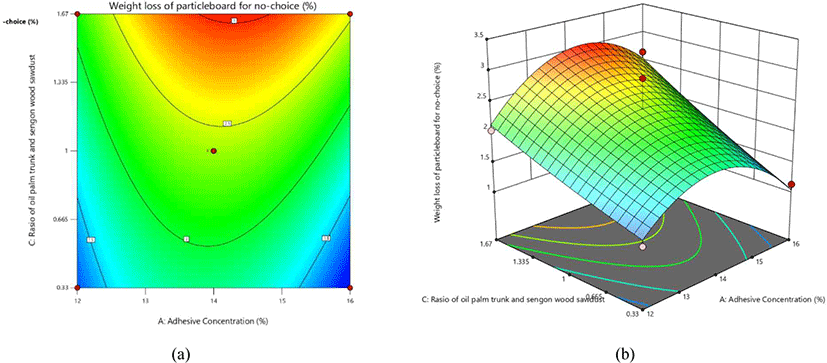
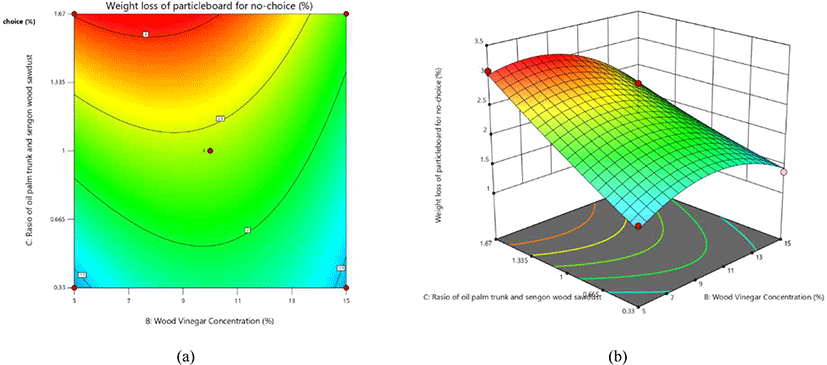
The multiple-choice method showed the weight loss due to termite attacks on particle boards and the effect of the research treatments. The multiple-choice method’s weight loss average was between 0.38% and 2.65% (Fig. 6). The lowest weight loss value was for particleboard, which had a composition of X1 (14%), X2 (15%), and a ratio of X3 (25/75). The highest weight loss value was for particleboard, which had a composition of X1 (12%), X2 (10%), and a ratio of X3 (75/25). Detailed data are shown in Table 2 for response Y2 in the actual value (A).
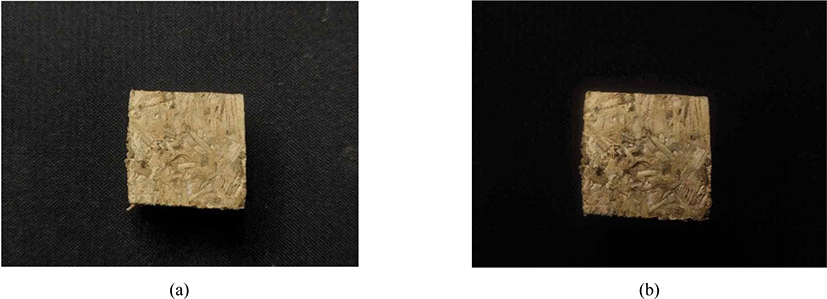
The addition of wood vinegar to particleboard has also been shown to increase its durability. The addition of wood vinegar from empty oil palm fruit bunches to particleboard has been shown to increase its durability. Our research results indicated that the addition of wood vinegar at concentrations of 5% and 10% increased the durability of the particle boards against termite attacks (Sunarti et al., 2014).
An illustration of the contour and surface response surfaces in Fig. 7 shows the interaction of X1 and X2 with weight loss in the multiple-choice method. The optimal conditions for particleboard were X1 (14%) and X2 (10%), with a weight loss value of 0.46%. Fig. 8 shows the interaction between X1 and the ratio of X3 under the optimum conditions of X1 (14%) and the ratio of X3 (50/50) with a weight loss value of 0.46%. The plot shows that increasing the concentration of wood vinegar provided maximum resistance to subterranean termite (C. curvignathus) attacks. Fig. 9 shows the interaction between X2 and the ratio of X3 under the optimum conditions of X2 (10%) and the ratio of X3 (50/50) with a weight loss value of particleboard multiple-choice testing of 0.46%.
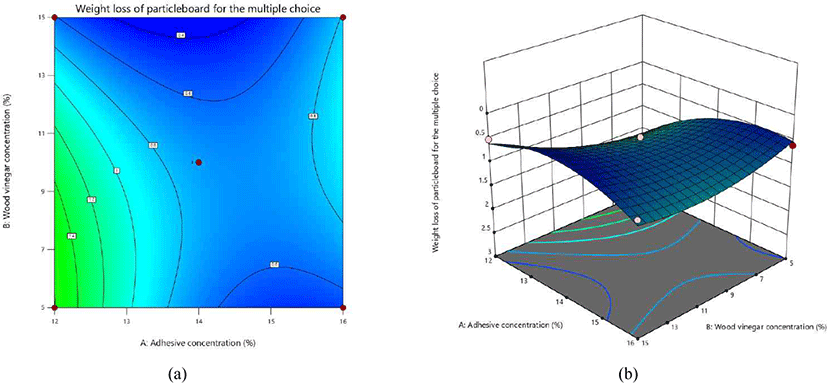
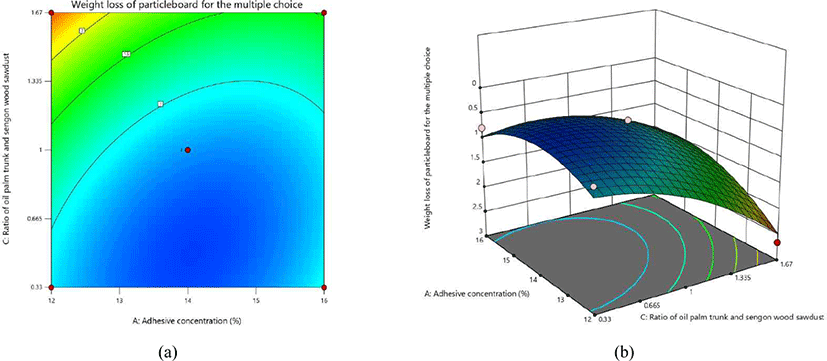
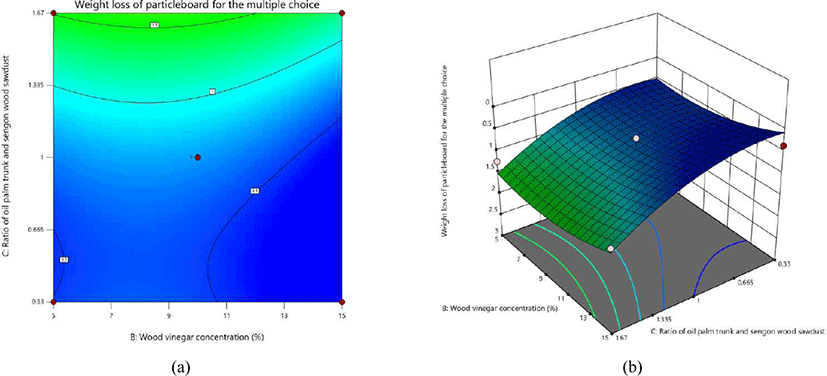
Based on the weight loss value of the particle board obtained from the test, the average weight loss value in the no-choice and multiple-choice methods ranged from 1.10% to 3.08% and 0.38% to 2.65%, respectively. Based on the particle board durability level classification in the SNI 01-7207 2006 standard (SNI, 2006), the particleboard was in a very durable category (durable class I). This showed that all research treatments affected the durability of the resulting particleboard. RSM demonstrated that the higher concentration of wood vinegar and adhesive increased the resistance of particle board to termite attacks, using the no-choice method and the multiple-choice method. This finding supports that of Arsyad et al. (2019), who found that wood vinegar can be used to increase the durability of wood against termite attacks.
Observation of termite feeding behavior by using the no-choice and multiple-choice methods was also conducted by Cosme et al. (2018, 2020). The results showed that in general, the durability of the tested samples exhibited the same phenomenon. However, when using the multiple-choice method, the preference for the consumption of certain woods was increasingly visible, illustrating that termites tend to consume wood with low durability (Cosme et al., 2018, 2020).
Mortality values ranged from 58.13% to 90.00%, with the lowest mortality percentage in particleboards with X1 (16%), X2 (5%), and the ratio of X3 (50/50). Additionally, the highest mortality value was in particleboard with a composition of X1 (16%), X2 (15%) and a ratio of X3 (50/50), which was 90%. Detailed data are shown in Table 2 for response Y3 in the actual value (A). The impact of the interaction between the adhesive concentration (X1), wood vinegar concentration (X2), and various ratios of oil palm trunk and sengon wood sawdust (X3) on termite mortality after exposure to particleboard is shown in the response surface 3D plots in Figs. 10–12. Both responses exhibited a quadratic trend with respect to the experimental variables [Figs. 10(b), 11(b), and 12(b)].
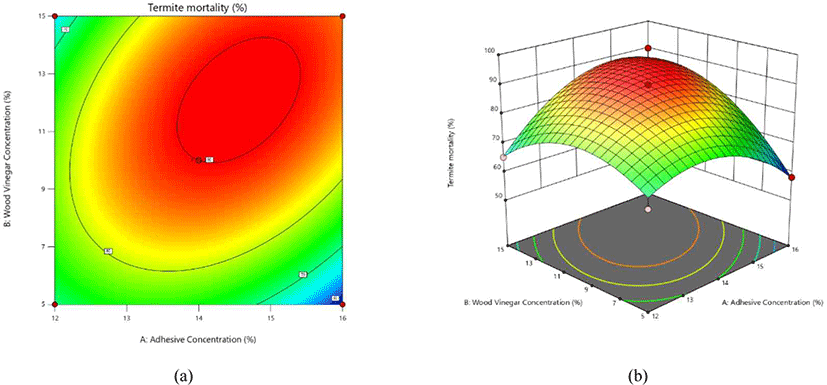
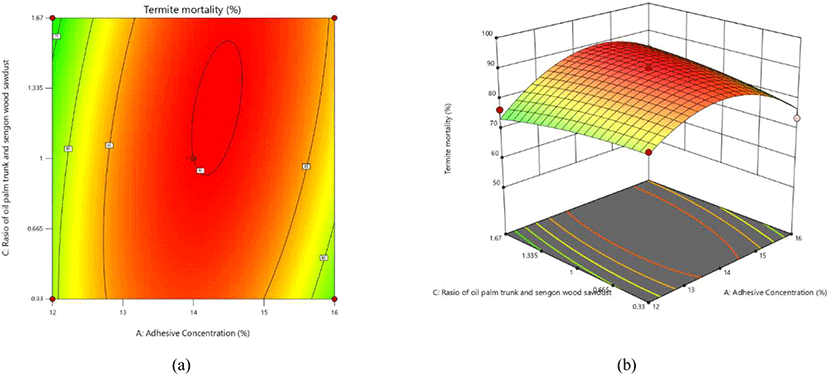
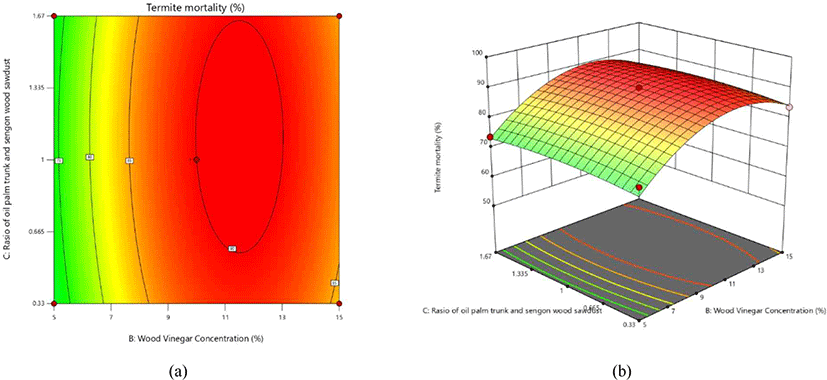
This study showed that a higher concentration of wood vinegar can increase the durability of particleboard. The acid, phenol, and carbonyl components of wood vinegar are toxic to termites and wood-rotting fungi (Oramahi et al., 2022b; Suprianto et al., 2023). Furthermore, increasing particle board hardness due to increasing adhesive concentration caused termite feeding ability to decrease. The hardness of the particleboard might have been caused by an increase in the number of glue lines owing to the increased adhesive concentration. This phenomenon was also reported by Cosme et al. (2018), who showed that the harder the wood, the greater the decrease in the termite feeding ability. This could have been caused by a decrease in the number of wood pores. Furthermore, the differences in the raw materials used affect the ability of termites to consume wood products. Cosme et al. (2020) showed that the level of termite consumption depended on the chemical components of the wood.
The RSM method was used to determine the durability of particleboard against termite attacks by using several research treatments. The RSM showed that increasing the concentrations of adhesive and wood vinegar affected termite mortality significantly. In line with Adfa et al. (2017) and Kadir et al. (2022), in this study, wood vinegar increased the resistance of wood to termite attacks. Other studies have shown that wood vinegar tested using the termite-repellent method on Whatman paper with C. formosanus (Oramahi and Yoshimura, 2013) and C. curvignathus (Oramahi et al., 2022b) also acted as biocides. Fig. 10 shows the termite mortality contour and surface, illustrating the effect of variables X1 and X2, the optimum conditions at X1 (14%) and X2 (10%). Increasing the concentration of the adhesive and wood vinegar resulted in a high mortality rate. The interaction between X1 and the ratio of X3 (Fig. 11) showed the optimum condition of X1 (14%) and the ratio of X3 (50/50), with a mortality value of 90%. The interaction between X2 and the ratio of X3 based on the contour and surface in Fig. 12 showed the optimum conditions for X2 (10%) and the ratio of X3 (50/50). The contour and surface response surface plots (3D) of the three images produced provided the same optimum results for all factors used with the combination of X1 (14%), X2 (10%), and the ratio of X3 (50/50), with a termite mortality value of 90%.
All contours and surfaces (3D) on the response surface plot interpreted the interaction between variables, showing the effect of the interaction between adhesive and wood vinegar, adhesive and the ratio of oil palm trunks to sengon wood composition, and wood vinegar and the ratio of oil palm trunks to sengon wood composition on particleboard resistance from subterranean termite (C. curvignathus) attacks and termite mortality. Based on the values given by the software using the RSM method to achieve optimum conditions for particle board durability against termite attacks, we recommend that the composition used be the concentration of adhesive, wood vinegar, and a ratio of oil palm trunks-sengon wood sawdust of 16%, 10%, and 25/75, respectively. The particle board composition produced the lowest weight losses in the no-choice and multiple-choice methods of 1.04% and 0.97%, respectively. Its composition was predicted to have a termite mortality rate of 76.78%.
4. CONCLUSIONS
This study attempted to predict the optimum conditions for particleboard durability against subterranean termite (C. curvignathus) attacks by using the RSM method in several research treatments: adhesive concentration, wood vinegar, and a combination of oil palm trunks and sengon wood. Particle board with a composition of 14% adhesive content, 5% wood vinegar, and a ratio of 75/25 oil palm trunks-sengon wood had the lowest resistance to subterranean termite (C. curvignathus) attacks in the no-choice test, with a weight loss test value of 3.08%. Particle board with a composition of 16% adhesive content, 15% wood vinegar, and a ratio of 50/50 oil palm trunks-sengon wood had the highest resistance to termite (C. curvignathus) attacks, with a weight loss test value of 1.10% and a mortality of 100%. Multiple-choice testing of particleboard with 12% adhesive content, 10% wood vinegar, and a 75/25 ratio of oil palm trunks-sengon wood had the lowest resistance to subterranean termite attacks (C. curvignathus), with a weight loss value of 2.65%. Particleboard with a composition of 14% adhesive content, 15% wood vinegar, and a ratio of 25/75 oil palm trunks-sengon wood had the highest resistance to termite attacks (C. curvignathus), with a weight loss test value of 0.38%.
Based on the calculation simulation by using the RSM method, the optimal results for the durability of particleboard from a combination of oil palm trunks-sengon wood with the addition of wood vinegar were 16% adhesive, 10% wood vinegar, and a ratio of 25/75 oil palm trunk–sengon wood. The higher the urea formaldehyde adhesive content and concentration of wood vinegar, the greater the durability of the produced particleboard.










